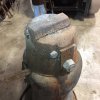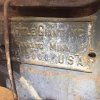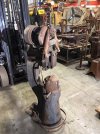- Joined
- Dec 27, 2013
- Messages
- 10,069
Hi everyone,
I was wondering if anyone else uses a VFD on their trip hammer. I'm using a cheap-o VFD on a 50-lb Little Giant, and love it. It allows using the motor in a simple direct-drive fashion (no gear reduction) while not turning the hammer too quickly with your foot to the floor on the clutch. When doing bulk forging, you just have to set your speed and just step on the clutch instead of slipping the old mechanism to get the speed you want. A 1 hp motor has plenty of power this way for a hammer this size, from very slow speed up to self-destruct mode!
Highly recommended! :thumbup:

I was wondering if anyone else uses a VFD on their trip hammer. I'm using a cheap-o VFD on a 50-lb Little Giant, and love it. It allows using the motor in a simple direct-drive fashion (no gear reduction) while not turning the hammer too quickly with your foot to the floor on the clutch. When doing bulk forging, you just have to set your speed and just step on the clutch instead of slipping the old mechanism to get the speed you want. A 1 hp motor has plenty of power this way for a hammer this size, from very slow speed up to self-destruct mode!
Highly recommended! :thumbup:






